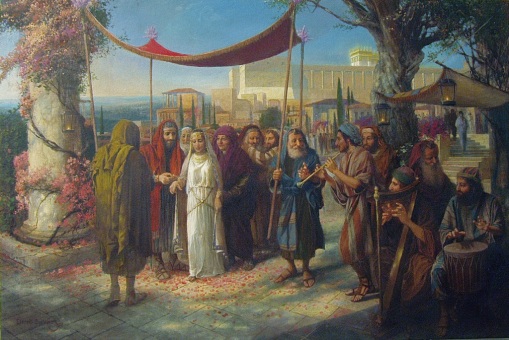Weddings in ancient Israel (Song of Solomon 3)
Illustration: The wedding of Matthew 25
A wedding, as the public solemnization of an agreement made at the time of an engagement, was an occasion for great joy. The ceremony itself most likely consisted of the recitation of simple formula, such as the one alluded to at the time of the first union between a husband and a wife (Genesis 2:23). Marriage contracts from the Jewish community of Elephantine of the fifth century B.C. record a vow common to the ancient world: The groom would declare that the woman was his wife and that he was her husband for eternity. The wedding ceremony also may have involved the symbolic act of the man covering his bride with the corner of his garment and that it was his responsibility to provide for her (Ruth 3:9, Ezekiel 16:8). Blessings of fruitfulness were bestowed upon the couple by family and friends (Genesis 24:60, Ruth 4:11-12).
A passage from the Babylonian Talmud tells us that at a Jewish wedding in the early Christian era a groom would wear a ceremonial crown and receive his bride, who would make her entrance at the wedding part in a sedan chair. This event may explain the description in Song of Solomon 3:6-11; it would appear that the bride was riding in such a sedan chair (NIV “carriage”), accompanied by an honour guard, (In the phrase “Who is this?” in 3:6 the word “this” is feminine, referring to a woman.) The bride’s entourage also included a musical procession (Psalm 45:14, 1 Maccabees 9:37-39). The groom was attired in festive headdress (Song of Solomon 3:11, Isaiah 61:10), and the bride was adorned in embroidered garments and Jewelry (Psalm 45:13-14 Isaiah 49:18, 61:10). A veil completed the virgin bride’s costume, which may partly explain the success of Laban’s ruse of substituting Leah for Rachel on Jacob’s wedding night (Genesis 29:23, Song of Solomon 4:1).
Jesus parable of the wise and foolish virgins (Matthew 25:1-13) describes the arrival of the groom during the night prior to the wedding. He was attended by male companions, one of whom would serve as his best man (Judges 14:20, John 3:29). Upon his arrival the groom’s family would host a feast (Matthew 22:2, John 2:9). Putting the evidence together, it appears that the groom with his companions would traditionally arrive at the ceremonial house first, during the night, to be received by a group of yung women. Early the next day the friends of the groom would go out to bring back the bride, who would arrive in a sedan chair with the groom’s friends as her symbolic honour guard.
The marriage would be consummated on the first night of a banquet celebration typically lasting for seven days (Genesis 29:27, Judges 14:12). The bridal couple would seal their union in a bridal chamber (Psalm 19:5, Joel 2:16), and the blood-stained nuptial sheet would be saved by the bride’s parents as proof of her prior virginity (Deuteronomy 22:17).
A wedding celebration in any time or culture typically brims with emotion, including the culmination of joy and the realization of an anticipated promise, thereby aptly expressing a believer’s union with Christ at the end of time. “Let us rejoice and be glad and give Him glory! For the wedding of the Lamb has come, and His bride has made herself ready. Fine linen, bright and clean, was given her to wear” (Revelation 19:7-8).
